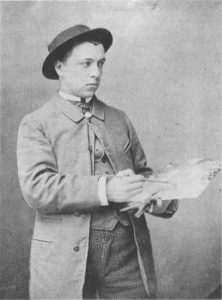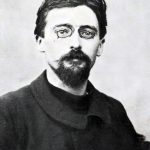
Movements: Post Impressionism, Pointillism
Paul Signac (1863 – 1935) was a French Post-Impressionist painter. He followed a course of training in architecture before, at the age of 18, deciding to pursue a career as a painter, after attending an exhibit of Monet’s work. He sailed on the Mediterranean Sea, visiting the coasts of Europe and painting the landscapes he encountered. In later years, he also painted a series of watercolors of French harbor cities.
In 1884 he met Claude Monet and Georges Seurat. He was struck by the systematic working methods of Seurat and by his theory of colors and he became Seurat’s faithful supporter, friend, and heir with his description of Neo-Impressionism and Divisionism method. Under Seurat’s influence he abandoned the short brushstrokes of Impressionism to experiment with scientifically-juxtaposed small dots of pure color, intended to combine and blend not on the canvas, but in the viewer’s eye, the defining feature of Pointillism.
In 1886 Signac met Vincent van Gogh in Paris. During 1887 the two artists regularly went to Asnières-sur-Seine together, where they painted such subjects as river landscapes and cafés. Initially, van Gogh chiefly admired Signac’s loose painting technique. In March 1889, Signac visited van Gogh at Arles. The next year he made a short trip to Italy, seeing Genoa, Florence, and Naples.
Signac loved sailing and began to travel in 1892, sailing a small boat to almost all the ports of France, to the Netherlands, and on the Mediterranean Sea as far as Constantinople, basing his boat at St. Tropez, which he later would make popular to other artists. From his various ports of call, Signac brought back vibrant, colorful watercolors, sketched rapidly from nature. From these sketches, he painted large studio canvases that are carefully composed of small, mosaic-like squares of color quite different from the tiny, variegated dots introduced and used by Seurat.
On 7 November 1892, Signac married Berthe Robles at the town hall of the 18th arrondissement of Paris. The witnesses at the wedding were Alexandre Lemonier, Maximilien Luce, Camille Pissarro, and Georges Lecomte.
Signac wrote several important works on the theory of art, among them, From Eugene Delacroix to Neo-Impressionism, published in 1899. It is a monograph devoted to Johan Barthold Jongkind (1819–1891), and was published in 1927. He also authored several introductions to the catalogues of art exhibitions and many other writings yet to be published.
Politically, he was an anarchist, as were many of his friends, including Felix Feneon and Camille Pissarro.
Click here to read more about Paul Signac on Wikipedia.
Signac painted several other places in France, which will be featured eventually on this site. A link “⇠” to those cities will appear below.
- Auvergne-Rhone-Alpes
- Bourg-Saint-Andeol
- Bourgogne-Franche-Comte (Burgundy)
- Auxerre
- Brittany
- Audierne
- Cancale
- Concarneau
- Ile-de-Brehat
- Landerneau
- Lezardrieux
- Paimpol
- Port-Louis
- Quimper
- Saint-Briac-sur-Mer
- Saint-Malo
- Vannes
- Corsica
- Ajaccio
- Hauts-de-France
- Dunkerque
- Normandy
- Bayeux (surrounding only) ⇠
- Caen (surrounding only)
- Cherbourg (and surroundings)⇠
- Barfleur ⇠
- Etretat
- Fecamp ⇠
- Granville
- Honfleur ⇠
- Le Havre ⇠
- Le Treport
- Les Andelys
- Mont Saint-Michel
- Rouen
- Trouville-sur-Mer ⇠
- Veules-les-Roses (surrounding only) ⇠
- Nouvelle-Aquitaine
- Biarritz
- La Rochelle
- Saint-Jean-de-Luz
- Occitanie
- Beaucaire
- Pays de la Loire
- Les Sables-d’Olonne
- Saint-Nazaire
- Provence-Alpes-Cote d’Azur
- Antibes
- Avignon
- Cannes
- Cassis
- Castellane
- Marseille
- Menton
- Nice
- Saint-Tropez
- Sete
- Toulon
- Villefranche-sur-Mer
Related Posts
- 10000
 Paul Victor Jules Signac was a French Neo-Impressionist painter who, working with Georges Seurat, helped develop the Pointillist style. He started training as an architect but quickly decided he wanted to be an artist. Here are 2 of his paintings we found which he made in Le Havre, Normandy.
Paul Victor Jules Signac was a French Neo-Impressionist painter who, working with Georges Seurat, helped develop the Pointillist style. He started training as an architect but quickly decided he wanted to be an artist. Here are 2 of his paintings we found which he made in Le Havre, Normandy. - 87
 Georges Pierre Seurat (1859 – 1891) was a French post-Impressionist artist. He devised the painting techniques known as chromoluminarism and pointillism and used conté crayon for drawings on paper with a rough surface. Seurat's artistic personality combined qualities that are usually thought of as opposed and incompatible: on the one…
Georges Pierre Seurat (1859 – 1891) was a French post-Impressionist artist. He devised the painting techniques known as chromoluminarism and pointillism and used conté crayon for drawings on paper with a rough surface. Seurat's artistic personality combined qualities that are usually thought of as opposed and incompatible: on the one… - 86
 Gustave Loiseau was a French Post-Impressionist painter, remembered above all for his landscapes and scenes of Paris streets. However he did paint a lot in Normandy,
Gustave Loiseau was a French Post-Impressionist painter, remembered above all for his landscapes and scenes of Paris streets. However he did paint a lot in Normandy, - 86
 Maurice Brazil Prendergast (1858 – 1924) was an American Post-Impressionist artist who worked in oil, watercolor, and monotype.
Maurice Brazil Prendergast (1858 – 1924) was an American Post-Impressionist artist who worked in oil, watercolor, and monotype. - 86
 Gustave Madelain (1867 - 1944) was French painter with his own interpretation of French post Impressionism. Madelain showed a number of canvases at Le Havre and at Rouen; though it was naturally in Paris that he had his greatest success.
Gustave Madelain (1867 - 1944) was French painter with his own interpretation of French post Impressionism. Madelain showed a number of canvases at Le Havre and at Rouen; though it was naturally in Paris that he had his greatest success.
